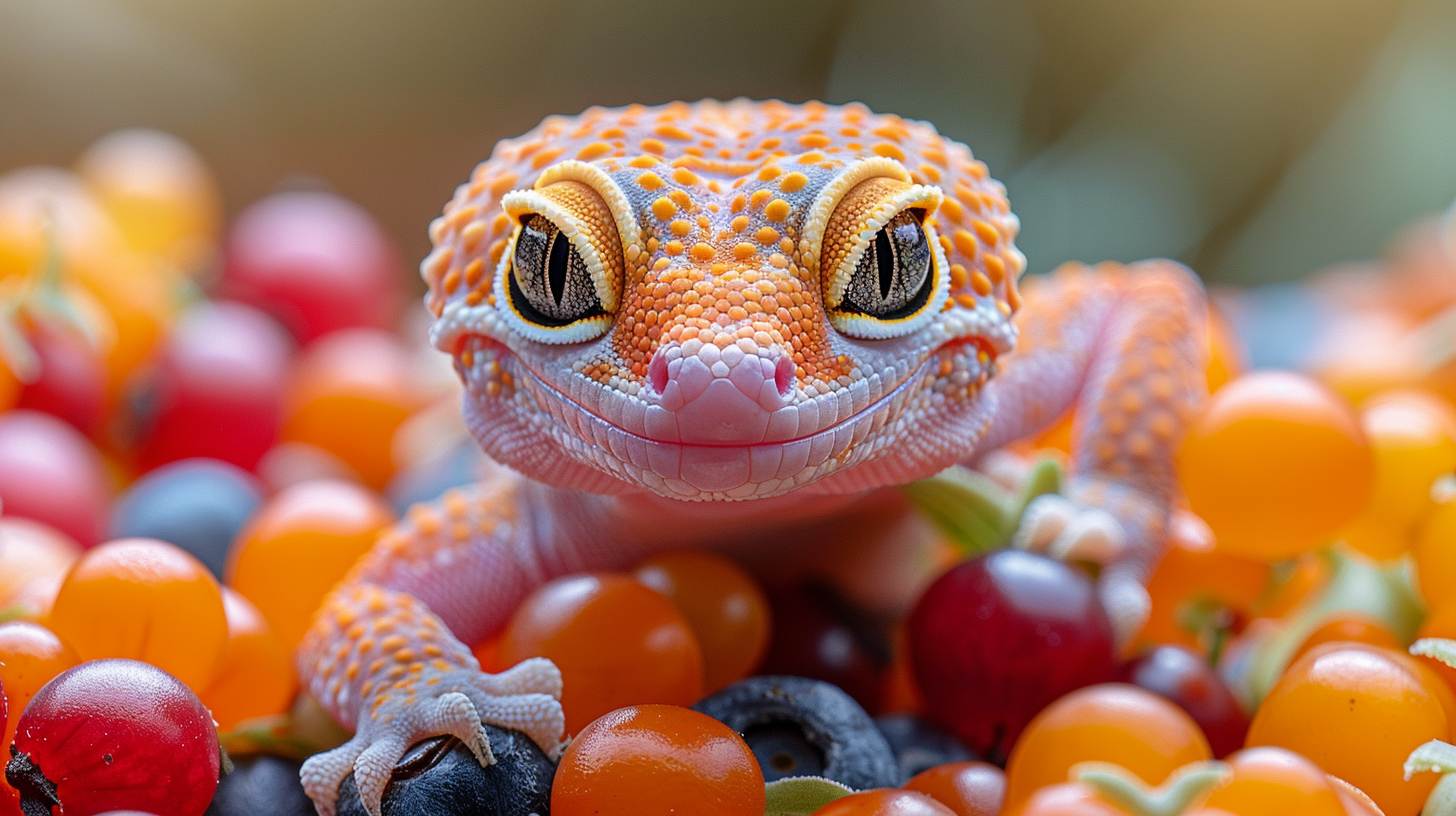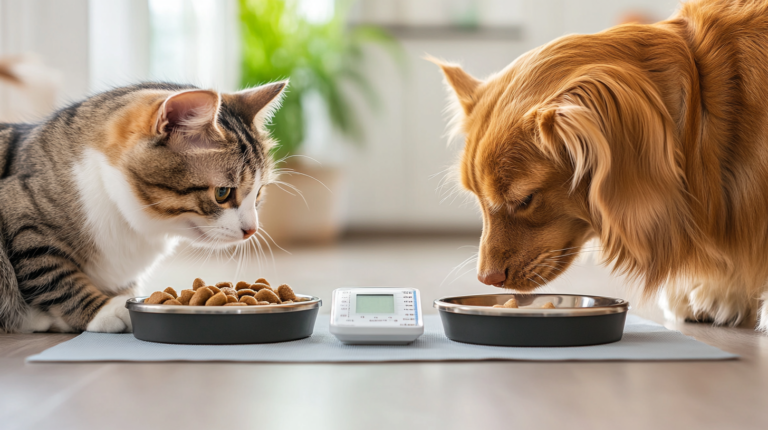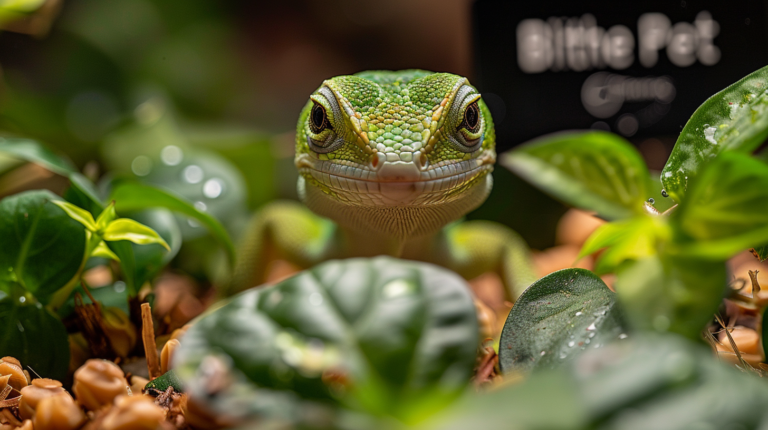Do leopard geckos eat fruit? Discover 3 shocking facts about gecko nutrition, safe feeding practices, and dietary requirements every pet owner should know.
Table of Contents
If you’re a leopard gecko owner or considering adding one of these charming reptiles to your family, you’ve likely wondered: do leopard geckos eat fruit? This question sparks curiosity among countless pet owners, and the answer might surprise you more than you think.
Leopard geckos have captivated reptile enthusiasts worldwide with their docile nature, beautiful patterns, and relatively simple care requirements. However, when it comes to their diet, misconceptions abound. Many new owners assume these spotted beauties can enjoy the same varied diet as other pets, including fresh fruits and vegetables. The reality is far more complex and fascinating than most people realize.
In this comprehensive guide, we’ll explore the shocking truth about leopard geckos and fruit consumption, dive deep into their natural dietary needs, and provide you with expert insights that will transform how you approach feeding your gecko. Whether you’re a seasoned reptile keeper or just starting your journey, these facts will reshape your understanding of proper leopard gecko nutrition.
Understanding Leopard Gecko Anatomy and Digestive System
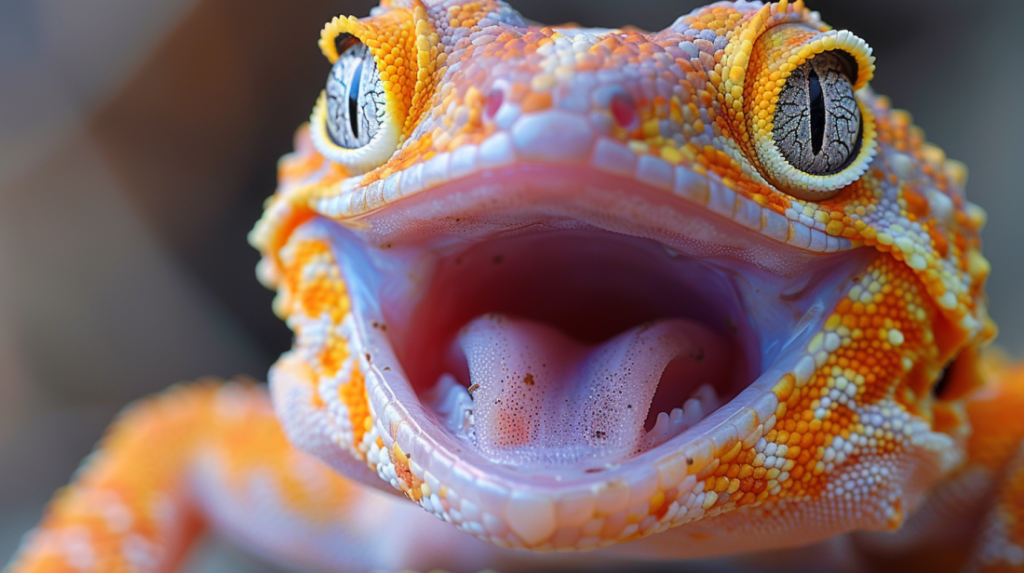
Before addressing whether leopard geckos eat fruit, it’s crucial to understand their unique anatomy and digestive capabilities. Leopard geckos (Eublepharis macularius) are insectivorous reptiles with specialized digestive systems designed specifically for processing animal protein.
The Insectivore’s Digestive Design
Leopard geckos possess a relatively simple digestive tract compared to omnivorous or herbivorous animals. Their stomachs are designed to break down chitinous exoskeletons and extract nutrients from insects. The length of their intestinal tract is significantly shorter than that of fruit-eating reptiles, which reflects their carnivorous nature.
Key anatomical features include:
- Short digestive tract: Optimized for quick protein processing
- Powerful stomach acid: Capable of breaking down insect exoskeletons
- Limited enzyme production: Lacks enzymes necessary for complex carbohydrate digestion
- Specialized teeth: Designed for gripping and crushing insects, not grinding plant matter
Metabolic Considerations
Leopard geckos have evolved over millions of years in arid environments where insects comprise the primary food source. Their metabolism is finely tuned to extract maximum nutrition from protein and fat sources while efficiently processing minimal carbohydrates.
Research conducted by the Journal of Herpetology indicates that leopard geckos maintain optimal health when their diet consists of 85-90% protein and 5-10% fat, with minimal carbohydrate content. This metabolic specialization makes them incredibly efficient at processing insects but poorly equipped to handle plant-based foods.
Shocking Fact 1: Leopard Geckos Cannot Properly Digest Fruit
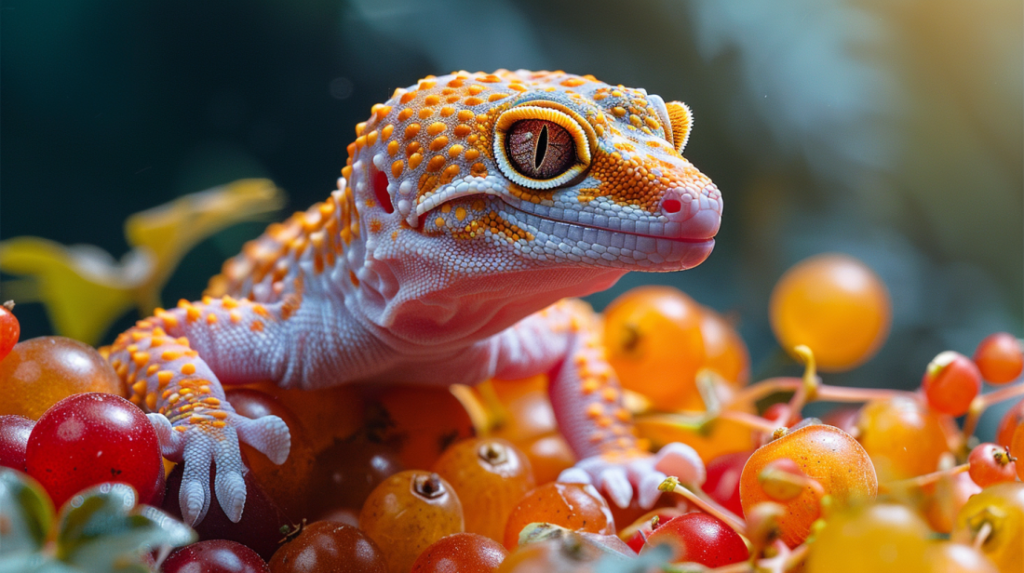
The first shocking revelation is that leopard geckos cannot properly digest fruit. This isn’t merely a preference issue—it’s a biological limitation that stems from their evolutionary history and digestive anatomy.
The Science Behind Fruit Digestion
Fruits contain complex carbohydrates, including fructose, glucose, and various fiber compounds. These require specific enzymes and gut bacteria to break down effectively. Leopard geckos lack many of these essential digestive components, making fruit consumption problematic rather than beneficial.
When leopard geckos consume fruit, several issues arise:
Enzyme Deficiency: Geckos produce insufficient amounts of amylase and other carbohydrate-digesting enzymes. This leads to incomplete digestion and potential fermentation in the gut.
Gut Flora Imbalance: The beneficial bacteria in a gecko’s digestive system are specialized for protein digestion. Introducing sugars and complex carbohydrates can disrupt this delicate balance, leading to digestive upset.
Sugar Overload: Fruits contain natural sugars that can overwhelm a gecko’s limited ability to process carbohydrates, potentially leading to metabolic stress.
Real-World Consequences
Dr. Sarah Martinez, a veterinary herpetologist with over 15 years of experience, explains: “I’ve treated numerous leopard geckos whose owners attempted to diversify their diet with fruits and vegetables. The most common issues include diarrhea, digestive impaction, and nutritional deficiencies despite well-meaning feeding attempts.”
Case studies from exotic veterinary clinics show that geckos fed fruit regularly often develop:
- Chronic digestive issues
- Weakened immune systems
- Metabolic bone disease
- Decreased lifespan
Shocking Fact 2: Fruit Can Be Toxic to Leopard Geckos
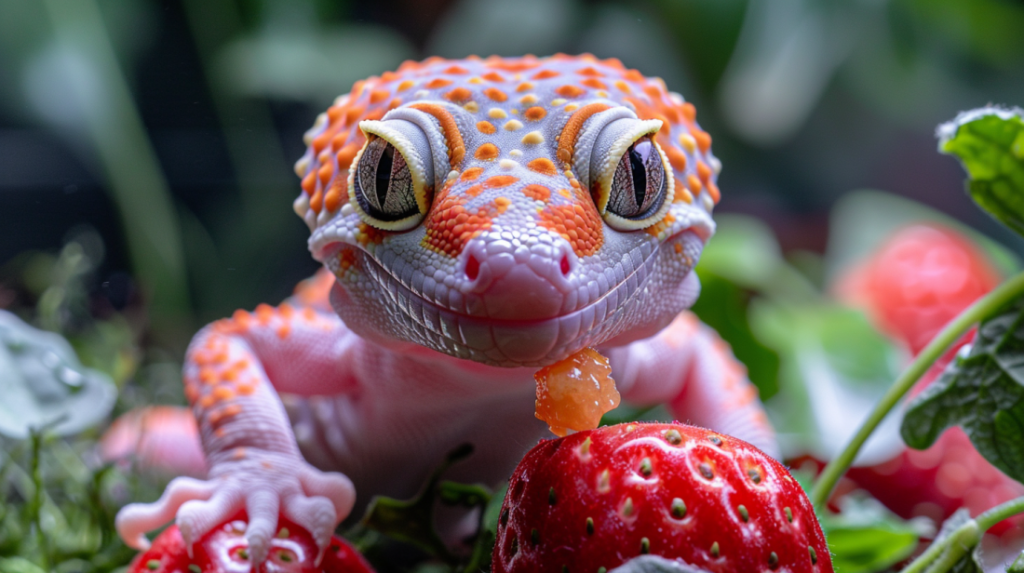
The second shocking fact is that certain fruits can be genuinely toxic to leopard geckos. What seems like a healthy, natural treat can actually pose serious health risks to these delicate reptiles.
Dangerous Fruits and Their Effects
Citrus Fruits: Oranges, lemons, limes, and grapefruits contain high levels of citric acid, which can cause severe digestive irritation and potential chemical burns in the gecko’s mouth and throat.
Avocado: Contains persin, a compound that’s toxic to many animals, including reptiles. Even small amounts can cause respiratory distress and cardiac issues.
Grapes and Raisins: While the exact mechanism isn’t fully understood, these fruits have been linked to kidney failure in various animal species and should be avoided entirely.
Stone Fruits: Peaches, plums, and cherries contain compounds that can interfere with calcium absorption, potentially leading to metabolic bone disease.
pH Balance Disruption
Fruits can dramatically alter the pH balance in a gecko’s digestive system. The natural acidity of many fruits can create an environment where harmful bacteria thrive while beneficial gut flora diminishes. This pH disruption can lead to:
- Chronic digestive inflammation
- Increased susceptibility to parasites
- Nutrient malabsorption
- Systemic health issues
Chemical Residues and Pesticides
Even organically grown fruits may contain residues that are particularly harmful to small reptiles. Leopard geckos are much more sensitive to chemical exposure than larger animals, and their limited ability to process and eliminate toxins makes them vulnerable to:
- Pesticide accumulation
- Heavy metal toxicity
- Preservative sensitivity
- Artificial coloring reactions
Shocking Fact 3: Some Geckos Will Eat Fruit (But Shouldn’t)
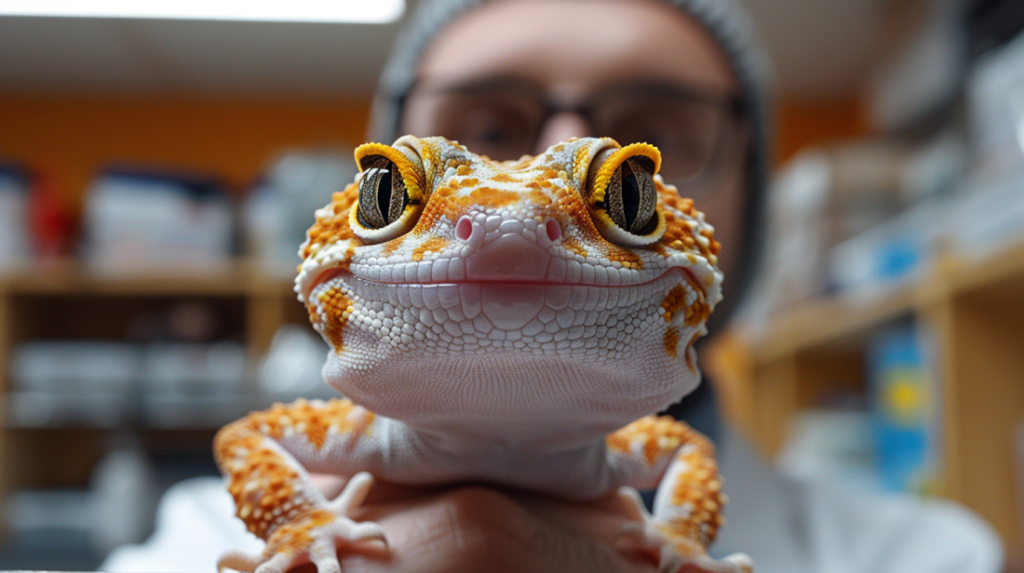
The third shocking fact is that some leopard geckos will actually eat fruit when offered, leading many owners to believe it’s safe and beneficial. This behavior creates a dangerous misconception that can have serious long-term consequences.
Why Geckos Eat Fruit Despite Biological Incompatibility
Several factors contribute to this seemingly contradictory behavior:
Opportunistic Feeding: In the wild, leopard geckos occasionally encounter fallen fruit and may investigate it as a potential food source. This doesn’t mean it’s beneficial—merely that their survival instincts drive them to explore potential nutrition sources.
Sweet Taste Preference: Like many animals, geckos can be attracted to sweet tastes, even when those foods aren’t appropriate for their digestive systems.
Hunger Response: A hungry gecko may eat almost anything offered, including inappropriate foods.
Curiosity and Exploration: Young geckos, in particular, may mouth or consume non-food items as part of their natural exploratory behavior.
The Palatability Trap
The fact that a gecko will eat fruit doesn’t indicate nutritional appropriateness. Dr. Michael Thompson, a reptile nutritionist, notes: “We see this phenomenon across many species—animals will often consume foods that taste good but provide no nutritional value or even cause harm. It’s similar to how humans enjoy candy despite knowing it’s not healthy.”
Long-Term Health Implications
Geckos that regularly consume fruit may not show immediate adverse effects, creating a false sense of security for owners. However, long-term consequences can be severe:
- Nutritional Deficiencies: Fruit consumption can displace proper insect nutrition
- Digestive Disorders: Chronic consumption leads to ongoing gut health issues
- Metabolic Imbalances: Disrupted blood sugar regulation
- Shortened Lifespan: Cumulative health effects reduce overall longevity
The Natural Diet of Leopard Geckos
Understanding what leopard geckos eat in their natural habitat provides crucial insight into their dietary needs. Native to the arid regions of Afghanistan, Pakistan, northwest India, and Iran, these geckos have evolved to thrive on a diet consisting entirely of insects and other small arthropods.
Wild Diet Composition
Research conducted in natural leopard gecko habitats reveals their diet consists of:
| Food Source | Percentage of Diet | Nutritional Value |
| Crickets | 35-40% | High protein, moderate fat |
| Mealworms | 20-25% | High protein, high fat |
| Beetles | 15-20% | Protein, chitin, minerals |
| Spiders | 10-15% | Protein, unique amino acids |
| Moth larvae | 5-10% | Protein, essential fatty acids |
| Other insects | 5-10% | Varied micronutrients |
Seasonal Variations
Wild leopard geckos experience natural seasonal variations in food availability, which influences their feeding patterns and nutritional needs. During the warmer months, insect populations boom, allowing geckos to build fat reserves. In cooler periods, they may experience natural fasting cycles.
This seasonal variation has equipped leopard geckos with remarkable metabolic flexibility, but only within the context of their natural insectivorous diet. They lack the adaptations necessary to process plant matter during any season.
Hunting Behavior and Food Selection
Leopard geckos are ambush predators with highly developed sensory systems for detecting and capturing prey. Their feeding behavior is triggered by:
- Movement: Motion activates their hunting instincts
- Size: Prey items should be no larger than the width of the gecko’s head
- Texture: The chitinous exoskeleton of insects provides necessary tactile feedback
- Nutritional density: Instinctively attracted to nutrient-rich prey
Proper Leopard Gecko Nutrition
Providing appropriate nutrition for captive leopard geckos requires understanding their specific dietary requirements and implementing feeding practices that mirror their natural diet while ensuring optimal health.
Essential Nutritional Components
Protein Requirements: Adult leopard geckos require approximately 20-25% protein in their diet, while juveniles need 30-35% to support growth and development. This protein should come exclusively from animal sources.
Fat Content: Healthy adult geckos need 5-10% fat in their diet. Higher fat content can lead to obesity, while insufficient fat can cause nutritional deficiencies.
Calcium and Phosphorus: The ideal calcium-to-phosphorus ratio is 2:1. This balance is crucial for proper bone development and preventing metabolic bone disease.
Vitamins and Minerals: Essential vitamins include A, D3, E, and various B vitamins. Minerals like calcium, phosphorus, magnesium, and trace elements are vital for physiological functions.
Recommended Feeder Insects
Crickets: The gold standard for leopard gecko nutrition. They provide excellent protein content and are readily available. Gut-load crickets 24-48 hours before feeding to maximize nutritional value.
Mealworms: High in protein and fat, mealworms are an excellent staple food. However, they should be fed in moderation due to their high fat content.
Dubia Roaches: Increasingly popular due to their excellent nutritional profile and ease of breeding. They’re high in protein and have an ideal calcium-to-phosphorus ratio.
Waxworms: Should be offered sparingly as treats due to their high fat content. They’re useful for encouraging appetite in sick or stressed geckos.
Silkworms: Excellent nutritional value with high protein and good calcium content. They’re particularly beneficial for breeding females and growing juveniles.
Feeding Schedule and Portions
Juveniles (0-12 months): Feed daily, offering 5-7 appropriately sized insects per feeding. Young geckos have high metabolic rates and need frequent nutrition.
Adults (1+ years): Feed every other day, offering 5-10 insects per feeding, depending on the gecko’s size and activity level.
Breeding Females: May require daily feeding with increased portions to support egg production.
Supplementation Protocol
Proper supplementation is crucial for captive leopard geckos:
Calcium with D3: Use 1-2 times per week for geckos with adequate UVB lighting, or 2-3 times per week for those without UVB.
Calcium without D3: Use on alternate feeding days to prevent D3 overdose.
Multivitamin: Use once per week to ensure adequate vitamin intake.
Gut-loading: Feed nutritious foods to feeder insects 24-48 hours before offering them to geckos.
Safe Alternatives to Fruit
While fruit isn’t appropriate for leopard geckos, there are safe ways to provide variety and enrichment in their diet without compromising their health.
Insect Variety for Nutritional Diversity
Seasonal Rotation: Rotate different insect species throughout the year to mimic natural dietary variations and prevent nutritional monotony.
Size Variation: Offer insects of different sizes (within appropriate limits) to encourage natural hunting behaviors.
Texture Differences: Include both soft-bodied insects (like silkworms) and hard-shelled insects (like crickets) to provide varied textures.
Enrichment Feeding Techniques
Hunting Simulation: Use feeding tongs to move insects, triggering natural hunting responses.
Scattered Feeding: Occasionally scatter insects around the enclosure to encourage foraging behavior.
Puzzle Feeders: Use specialized reptile puzzle feeders to make meal time more engaging.
Occasional Treat Options
Pinky Mice: Adult geckos can occasionally have pinky mice as a protein-rich treat (no more than once per month).
Hornworms: These caterpillars are high in moisture and protein, making them excellent occasional treats.
Phoenix Worms: High in calcium and protein, these are nutritious occasional additions to the diet.
Common Feeding Mistakes to Avoid
Understanding common feeding mistakes helps prevent health issues and ensures your leopard gecko receives optimal nutrition throughout their life.
Overfeeding Concerns
Obesity Prevention: Overfeeding is one of the most common problems in captive leopard geckos. Signs include:
- Visible fat deposits around the neck and tail base
- Difficulty moving or lethargy
- Reduced appetite despite continued feeding
- Shortened lifespan
Portion Control: Follow feeding guidelines based on your gecko’s age, size, and activity level. A well-fed gecko should have a plump tail without visible fat rolls.
Inappropriate Food Choices
Fireflies and Lightning Bugs: These contain luciferin, which is toxic to reptiles and can cause death.
Wild-Caught Insects: May contain parasites, diseases, or chemical residues harmful to geckos.
Insects from Bait Shops: Often treated with chemicals or fed inappropriate diets.
Dead Insects: Lack nutritional value and may harbor harmful bacteria.
Supplementation Errors
Over-Supplementation: Too much calcium or vitamin D3 can cause health problems including kidney issues and metabolic imbalances.
Inconsistent Supplementation: Irregular supplementation can lead to nutritional deficiencies.
Poor Quality Supplements: Using expired or low-quality supplements provides inadequate nutrition.
Recognizing Nutritional Deficiencies
Early recognition of nutritional deficiencies allows for prompt intervention and prevents serious health complications.
Metabolic Bone Disease (MBD)
MBD is the most common nutritional disorder in captive leopard geckos:
Early Signs:
- Difficulty walking or climbing
- Tremors or shaking
- Reduced appetite
- Lethargy
Advanced Signs:
- Visible bone deformities
- Inability to support body weight
- Seizures
- Paralysis
Prevention: Proper calcium supplementation, adequate UVB lighting, and appropriate diet.
Vitamin A Deficiency
Signs include:
- Swollen or closed eyes
- Respiratory infections
- Poor appetite
- Skin problems
Protein Deficiency
Symptoms include:
- Stunted growth in juveniles
- Muscle wasting
- Poor wound healing
- Reproductive problems
Creating a Feeding Schedule
A consistent feeding schedule promotes healthy digestion and helps monitor your gecko’s health status.
Daily Routine Considerations
Timing: Feed geckos during their active hours (evening to early morning) to align with their natural circadian rhythms.
Consistency: Maintain regular feeding times to establish healthy routines.
Observation: Monitor feeding behavior and appetite changes as indicators of health status.
Record Keeping
Maintain feeding records including:
- Date and time of feeding
- Type and quantity of insects offered
- Supplements used
- Feeding behavior observations
- Any refused food or unusual behavior
Seasonal Adjustments
Breeding Season: Increase feeding frequency for breeding animals.
Brumation: Reduce feeding frequency as geckos enter natural dormancy periods.
Growth Periods: Adjust portions for rapidly growing juveniles.
Health Monitoring Through Diet
Your gecko’s feeding behavior provides valuable insights into their overall health status.
Normal Feeding Behaviors
Healthy Appetite: Regular interest in food during feeding times.
Active Hunting: Engagement with moving prey items.
Complete Consumption: Finishing offered meals without leaving excessive leftovers.
Regular Defecation: Normal bowel movements indicate proper digestion.
Warning Signs
Appetite Loss: Refusing food for more than a week warrants veterinary attention.
Selective Eating: Suddenly refusing previously accepted foods.
Regurgitation: Vomiting food shortly after consumption.
Abnormal Defecation: Changes in frequency, consistency, or appearance of waste.
Environmental Factors Affecting Appetite
Environmental conditions significantly impact feeding behavior and digestive health.
Temperature Requirements
Basking Spot: 88-92°F (31-33°C) for proper digestion.
Cool Side: 75-80°F (24-27°C) to allow thermoregulation.
Nighttime: 70-75°F (21-24°C) for natural temperature cycling.
Humidity Levels
Maintain 30-40% humidity to support proper shedding and respiratory health without encouraging bacterial growth.
Lighting Considerations
UVB Lighting: While not strictly necessary, UVB lighting can improve calcium metabolism and overall health.
Day/Night Cycle: Maintain natural lighting cycles to support circadian rhythms.
The Role of Hydration
Proper hydration supports digestion and overall health in leopard geckos.
Water Requirements
Fresh Water: Provide clean, chlorine-free water in a shallow dish.
Misting: Light misting can increase humidity and provide drinking opportunities.
Moisture from Food: Insects provide significant hydration, especially gut-loaded feeders.
Signs of Dehydration
- Sunken eyes
- Lethargy
- Dry, sticky mouth
- Skin tenting when pinched
For more expert pet care tips and product recommendations, visit BlithePet.com — your trusted source for pet wellness.
Frequently Asked Questions
Can leopard geckos eat any fruits at all?
No, leopard geckos should not eat any fruits. Their digestive systems are specifically designed for processing insects and cannot properly digest fruits. Even small amounts can cause digestive upset and nutritional imbalances.
What happens if my leopard gecko accidentally eats fruit?
If your gecko accidentally consumes a small amount of fruit, monitor them closely for signs of digestive upset such as diarrhea, lethargy, or loss of appetite. Contact a reptile veterinarian if symptoms persist or worsen.
Are there any vegetables that are safe for leopard geckos?
No, leopard geckos should not eat vegetables either. They are obligate insectivores, meaning their nutritional needs must be met entirely through insect consumption. Vegetables can cause the same digestive issues as fruits.
How do I provide variety in my gecko’s diet without using fruits or vegetables?
Provide variety by offering different types of insects such as crickets, mealworms, dubia roaches, silkworms, and waxworms. Rotate these insects and vary feeding methods to maintain interest and nutritional diversity.
Can baby leopard geckos eat fruit since they’re still developing?
No, baby leopard geckos should never eat fruit. Juveniles actually have more sensitive digestive systems than adults and require a diet even higher in protein to support their rapid growth and development.
What should I do if my gecko seems bored with their insect diet?
Try different feeding methods such as using tweezers to simulate hunting, offering insects of varying sizes, or using puzzle feeders. You can also rotate between different insect species to provide natural variety while maintaining proper nutrition.
Conclusion
Understanding that leopard geckos cannot and should not eat fruit is crucial for every responsible gecko owner. These three shocking facts—that geckos cannot properly digest fruit, that fruit can be toxic to them, and that some geckos will eat fruit despite it being harmful—highlight the importance of species-appropriate nutrition.
Proper leopard gecko care requires commitment to providing a diet that mirrors their natural insectivorous needs. By focusing on high-quality feeder insects, appropriate supplementation, and consistent feeding schedules, you can ensure your gecko lives a long, healthy, and happy life.
Remember that while it might seem limiting to feed only insects, this specialized diet is exactly what leopard geckos have evolved to thrive on. Their remarkable adaptation to this dietary niche is part of what makes them such fascinating and rewarding pets.
The key to successful leopard gecko ownership lies in understanding and respecting their biological needs rather than imposing human preferences about dietary variety. By providing appropriate nutrition, you’re giving your gecko the best possible foundation for optimal health and longevity.
Have a similar experience with your pet? Share it in the comments below!

